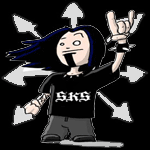Saturday, June 19, 2010
What to expect from Meego OS User Interface !
Some days ago i came across an interesting article from MeeGo Wiki page which describe the User Interface of the upcoming Meego Handset ! And guess what, the page has been deleted ! But hey, thanks to the magical google's webcache ;)
Anyway, some highlighted contents which i found interesting :
Lock Screen
- The lock screen is presented when the user presses the power key to wake the device from idle state.
- The screen presents the wallpaper (customizable by the user), date and time, and the lock action button. The device is unlocked by dragging the lock button into the wallpaper area.
- Notifications are also supported in the lock screen. They stack up in a similar way to the Notification Drawer.
Launcher
The launcher is a view that contains links to all applications installed in the device. In the launcher, the user can browse through the applications and add up to 4 links to the quick launch bar at the bottom of the screen. In editing mode, the user can also change the order of application links.
Applications are presented in a 4 x 4 grid. In the case where there are more than 16 applications, more pages of the same grid are added to the right. Paging through the different grids is done by swiping the current grid off screen, hence bringing the new one into view. When the user installs a new application, it goes to the end of the application grid.
The user opens the launcher by selecting an icon at the bottom of the Homescreen (placed together with Favorite Application links). To close, the same icon is used.
Order of Applications, Browsing, and Changing Modes
Tasks are shown in the order they were opened, from left to right. Every time a new task is opened, it pushes the previous task panels to the left and adds its thumbnail view to the far right.
The default view of the switcher presents the latest accessed task in focus, with the other, different tasks running to the right. Thumbnails are presented in chronological order, as they are opened.
It is possible to browse through the thumbnails, one by one, by slowly dragging them, or to use a quick swipe to rapidly pan from one side of the list to the other. During this quick swipe, a tap stops the transition at tapped point, but does not open the application. To open the application, the user needs to tap the desired thumbnail.
Users can use a pinch multi-touch motion to change the switcher into an overview mode. By pinching in, thumbnails move into a grid display. The grid can scale up to a 3x3 version, thereafter the switcher then starts to create new pages. Pinching out, while in the grid mode, changes the view back to larger stacked mode.
Text Input
Extra keyboard line The framework offers the possibility of customizing the keyboard by adding an extra virtual line to the pad. This line may receive custom-made buttons, for example, a ‘.com’ button for the browser keyboard. When the hardware keyboard is opened, the extra virtual line still appears (it is possible to dismiss it by dragging it down).
In addition, the system uses this extra line for advance functions, such as Copy/Paste. If the user selects a section of the text (drag and hold gesture), the extra line appears with the copy function available. Once the user actions copy, the same button reverts to paste. More on Copy & Paste section of this document.
Portrait vs. Landscape
Device orientation will suite multiple Applications in different ways. While watching a video is best done on landscape – with the media taking up all the screen, scrolling long lists is more comfortable on portrait.
MeeGo common components are always provided for both orientations. In other words, by using them, there is not need for extra work. It is advice able, however, that anyone building an Application acknowledges such change, as it might impact the desired experience.
Applications can overwrite default changes. However, it is highly recommended that all Application provide both portrait and landscape mode. The main reason is the form factor of some available MeeGo devices. In a devices with a slide hardware Qwerty, the landscape experience becomes key, and somehow extended. Therefore, the user shouldn’t be forced to change orientation to complete a task. Playing a game is one of the few exceptions to this rules, as its experience flow does not require (in most cases) the use of any other application.
Changing views should not introduce new or different content or functionality. Assets can be subtlety resided and/or reshuffled to make better use of the screen real estate.
1 vs. 2 Columns
Lists are probably the most common UI layout, and have a particular behavior depending on the orientation.
Whereas portrait allows for more items to be presented, landscape presents the possibility to extend the content area of a particular item. This is specially useful for text strings, which in landscape get more character area. The title of a message, for example, has less chance of being truncated.
Some Applications may consider splitting lists in two columns when on landscape to optimize space usage. This may be used when there is no hierarchical order, usually in first level drill down pages. However, this should never be done when the list follows a specific order criteria (such as chronological, alphabetical, etc).
Buttons should always be centralized (specially important due to two column split) and, full width in both orientations.
i'm going to keep reading the rest of the page too !





No Response to "What to expect from Meego OS User Interface !"
Leave A Reply